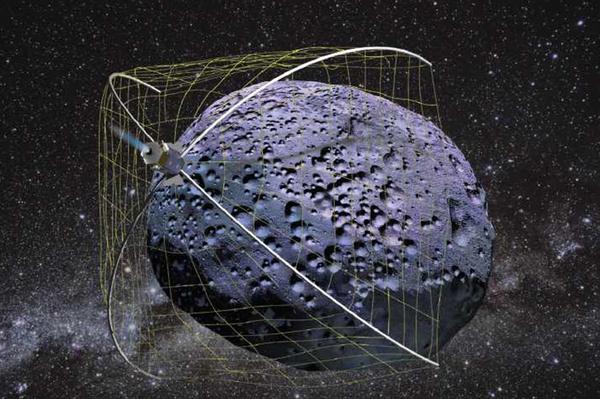| Online: | |
| Visits: | |
| Stories: |
NASA’s Asteroid Redirect Mission Will It Work?
NASA’s Asteroid Redirect Mission Will It Work?
Bothell’s Tethers Unlimited Wins NASA Funding To Lasso An Asteroid

The first step will be to catch an asteroid in a net, and then extend the tether.
“The truth, always the truth–at all costs”
I will strive to give you perspectives on the news that you will rarely receive from other sources. At times, there will be eye-witness reports from troubled areas, at other times, there will be documentary,interviews and other interesting works.
I am committed to providing information by posting/archiving videos, articles, and links. I also investigate to raise awareness on numerous issues, inspire critical thinking, involvement, and hopefully to help make our world a better place for all.
According to a recently published report, the report states Robert Hoyt wants to pull asteroids out of orbit with the equivalent of dental floss.
And NASA is planning to pay him to do it.
Tethers Unlimited Inc., a 15-person Bothell company founded by physicist Hoyt, has won a $200,000 contract from NASA’s Innovative Advanced Concepts (NIAC) program to develop the technology further.
“It’s a phase one that hopefully will lead to a bigger phase two,” Hoyt said in an interview.
He’s calling the concept WRANGLER, an acronym based on the convoluted “Weightless Rendezvous And Net Grapple to Limit Excess Rotation.” The idea is to attach a tether to a spinning asteroid, and then slowly reel it out so that the asteroid stops spinning, like a spinning ice skater who slows by extending her arms.
A tiny satellite called a nanosatellite would deploy the tether.
“The tether can be tiny — about as thin as dental floss — but if we deploy several miles of it between the asteroid and the nanosatellite, the tether provides incredible ‘leverage’ to enable a nanosatellite weighing just 22 pounds to de-spin an asteroid massing 1,000 tons,” Hoyt said. “It transfers the rotational energy and momentum to the nano-sat.”
Published on May 19, 2014
What if there was a way to alter the tracks of asteroids and therefore eliminate the threat they pose to us here on earth?
NASA says there is. The agency calls it the asteroid redirect mission. The Obama administration has asked Congress for $133 million in the 2015 fiscal year to fund it. The goal is to find an asteroid near earth, lasso it, and eventually send humans to land on it and study it.
NASA also wants to prove that it can move an asteroid in case one is on a collision course with us.
Published on Apr 10, 2013
SKYVIEWS HOW NASA INTENDS TO CAPTURE AN ASTEROID (report below)
SORTA KINDA MAYBE (full screen recommended)
Earlier today (April 10, 2013), President Obama and NASA released details of the FY 2014 budget, which includes $100 million for what NASA calls the Asteroid Retrieval and Utilization Mission.
NASA wants to begin work on what would ultimately send a robot spacecraft toward a rendezvous with a near-Earth object (NEO). The spacecraft would capture the asteroid, then steer it to the Earth-moon libration point (EML2), a relatively stable (but moving) gravitational point in space (because not as much fuel is required to maintain a spacecraft at this point).
The EML2 point is located on the MOON’S FAR SIDE. After the captured asteroid is situated there, human astronauts would launch from Earth to rendezvous with it and begin their studies.
This video is definitely worth watching! It’ll show you, without words, what NASA intends, sorta, kinda, maybe ~ Audio: Andy Hawk and The Train Wreck Endings.
Bottom line: NASA and President Obama today officially announced a proposed budget item ($100 million) for the Asteroid Retrieval and Utilization Mission.
Traffic Report on 11 April ’13
Three objects reported inside ten LD
There are three asteroids reported to be within ten lunar distances (LD) of our planet today.
Risk-listed 2010 GM23 may be inbound from 9.6 to 7.0 LD*, newly announced risk-listed 2013 GW38 departs from inside ten LD, traveling from 7.68 to 10.01 LD, and new discovery 2013 GB55 enters ten LD, passing from 10.38 to 9.93 LD.
Approaching our neighborhood next, 2013 GH23 arrives inside ten LD on April 16th, 2013.
This report was updated at 2151 UTC with new discoveries 2013 GB55 (MPEC) and departees 2013 GD55 (MPEC) and risk-listed 2013 GA55 (MPEC).
Today’s first traffic report was generated at 0452 UTC with the discovery announced late yesterday of 2013 GW38 (MPEC). Video entry submitted by ~tina marie.
sources: earth sky dot org
Audio: Musical Artist and Song Writer: Andy Hawk and the Train Wreck Endings
website: Andyhawk dot com
Song: Sorta Kinda Maybe
Album: Sorta Kinda Maybe
Love and light. ~tina marie




